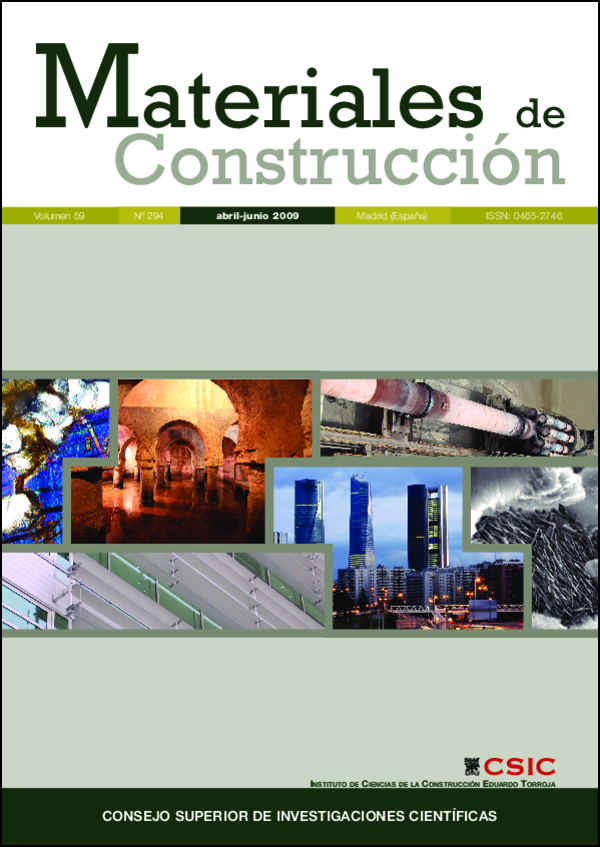Thermodinamically stable phases in the CaO-SiO2-Al2O3-CaSO4-H2O closed system at 25 ºC. Application to cementitious systems
DOI:
https://doi.org/10.3989/mc.2009.45407Keywords:
thermodynamic stability, cement, C-S-H gel stability, sulphatesAbstract
One of the chief causes of cement and concrete deterioration is the loss of durability prompted by sulphate attack. The existing standards call for long test periods (2- 12 months). Thermodynamic modelling is a particularly appropriate technique for studying systems that only reach equilibrium in the long term. Used in the present study to establish the fields of thermodynamic stability for the phases in the CaO-SiO2-Al2O3-CaSO4-H2O system at 25 ºC. According to the model, gypsum is stable at sulphate ion concentrations of 1.23e-2 mol/kg and over, while ettringite exhibits stability at concentrations ranging from 7.64e-6 to 1.54e-2 mol/kg.
Ettringite is compatible with all system phases except SH and gypsum only with ettringite, the C-S-H gels, AH3 and SH. None of the calcium aluminates or silicoaluminates in the system is compatible with gypsum: in its presence, they all decompose to cement deteriorating ettringite.
Finally, the model revealed that the maximum sulphate concentration at which C-S-H gel is stable is slightly higher in systems with than without Al2O3.
Downloads
References
(1) Neville, A. M.: Properties of Concrete, Addison Wesley Longman Limited, Essex, England (1995).
(2) Santhanam, M.; Cohen, M. D.; Olek J.: “Sulfate attack research-whither now?”. Cem. Concr. Res., vol. 41 (2001), pp. 845-851. doi:10.1016/S0008-8846(01)00510-5
(3) Collepardi, M.: “A state-of-the-art review on delayed ettringite attack on concrete”. Cement and Concrete Composite, vol. 25 (2003), pp. 401-407. doi:10.1016/S0958-9465(02)00080-X
(4) Taylor, H. F. W.: Cement Chemistry, Academic Press Limited, London, UK 1990.
(5) ASTM-C1012:2004: Standard test method for length change of hydraulic cement mortars exposed to a sulphate solution.
(6) GOST 4798-69: “Hydraulic-engineering concrete. Methods for testing materials for preparation”.
(7) Koch, A.; Steinegger, H.: “A rapid test method for cements for their behaviour under sulphate attack”. Zement Kalk Gips 7 (1960), pp. 317-324.
(8) Aguilera, J.: “Efectos provocados por el ataque conjunto de los agentes atmosféricos CO2 y SO2. Condiciones termodinámicas que permiten la formación de taumasita y sus efectos destructivos en los morteros de cemento”. Ph D thesis, Universidad Complutense Madrid (2003).
(9) Damidot, D.; Glasser, F. P.: “Thermodynamic investigation of the CaO-Al2O3-CaSO4•H2O system at 25 ºC and the influence of Na2O”. Cem. Concr. Res., 23 (1993), pp. 221-238. doi:10.1016/0008-8846(93)90153-Z
(10) Damidot, D.; Barnett, S. J.; Glasser, F. P.; Macphee, D. E.: “Investigation of the CaO-Al2O3-SiO2-CaSO4-CaCO3-H2O system at 25 ºC by thermodynamic calculation”. Advances in Cement Research, vol. 16, nº 2 (2004), pp. 69-76. doi:10.1680/adcr.16.2.69.36253
(11) Matschei, T.; Lothenbach, B.; Glasser, F. P.: “Thermodynamic properties of Portland cement hydrates in the system CaO-Al2O3- SiO2-CaSO4-CaCO3-H2O”. Cem. Concr. Res., vol. 37 (2007), pp. 1379-1410. doi:10.1016/j.cemconres.2007.06.002
(12) Sánchez De Rojas, M.I.; Sotolongo, R.; Frías, M.; Sabador, E.; Marín, F.: “Thaumasite Formation due to the Use of Aggregates with High Carbonate and Sulphate Content”. XII International Congress on the Chemistry of Cement, Canada, Ed. Beaudoin, J.J.; Makar, J.M., Rak, L. (July 2007).
(13) Lothenbach, L.; Wieland, E.: “A thermodynamic approach to the hydration of sulphate-resisting Portland cement”. Waste Management, vol. 26 (2006), pp. 706-719. doi:10.1016/j.wasman.2006.01.023 PMid:16529919
(14) Langmuir, D.; Mahoney, J.; Rowson, J.: “Solubility products of amorphous ferric arsenate and crystalline scorodite (FeAsO4•2H2O) and their application to arsenic behavior in buried mine tailings”. Geochimica et Cosmochimica Acta, vol. 70 (2006), pp. 2.942-2.956.
(15) Parkhurst, D. L.; Thorstenson, D. C.; Plumier, L. N.: “Phreeque- A computer program for geochemical calculations”. U.S Geological Survey, USGS-WRI-80-96, 1980.
(16) Strönach, S. A.: “Thermodinamic modelling and phase relations of cementitious systems”. Ph D Aberdeen Univ., 1996.
(17) Kersten, M.: “Aqueous solubility diagrams for cementitious waste stabilization systems. 1. The C-S-H solid-solution system”. Environ. Sci. Technol, vol. 30, nº 7 (1996), pp. 2286-2293. doi: 10.1021/es95068/b doi:10.1021/es950681b
(18) Jappy, T. G.: Silica substituted calcium aluminate hydrate garnets, Ph D Abeerden Univ. 1992.
(19) Atkins, M.; Glasser, F. P.; Kindness, A.; Macphee, D. E.: “Solubility data for cement hydrate phases (25 ºC)”. DoE report No DOE/HMIP/RR/91/032 (1991).
(20) Rivas-Mercury, J. M.; Pena, P.; Turrillas, X.; De aza, A. H.; Sobrados, I.; Sanz, J.: “Solid-state 27Al and 29Si NMR investigation of Si-substituted hydrogarnets”. Acta Materialia, vol. 55(4) (2007), pp. 1183-1191 doi:10.1016/j.actamat.2006.09.032
(21) Damidot, D.; Glasser, F. P.: “Investigations of the CaO-SiO2-Al2O3-H2O system at 25 ºC by thermodynamic calculations”. Cem. Concr. Res., vol. 25 (1995), pp. 22-28. doi:10.1016/0008-8846(94)00108-B
Downloads
Published
How to Cite
Issue
Section
License
Copyright (c) 2009 Consejo Superior de Investigaciones Científicas (CSIC)

This work is licensed under a Creative Commons Attribution 4.0 International License.
© CSIC. Manuscripts published in both the print and online versions of this journal are the property of the Consejo Superior de Investigaciones Científicas, and quoting this source is a requirement for any partial or full reproduction.
All contents of this electronic edition, except where otherwise noted, are distributed under a Creative Commons Attribution 4.0 International (CC BY 4.0) licence. You may read the basic information and the legal text of the licence. The indication of the CC BY 4.0 licence must be expressly stated in this way when necessary.
Self-archiving in repositories, personal webpages or similar, of any version other than the final version of the work produced by the publisher, is not allowed.
















